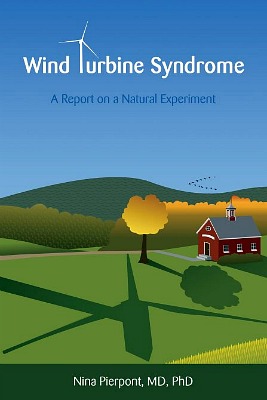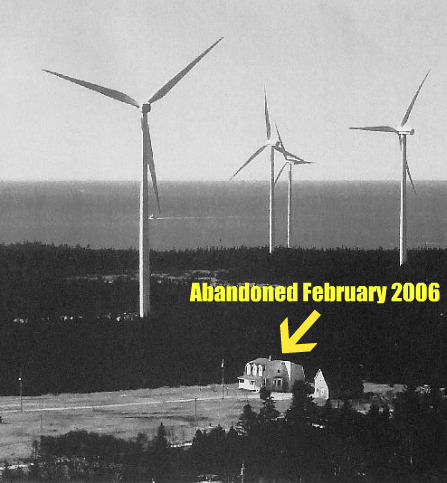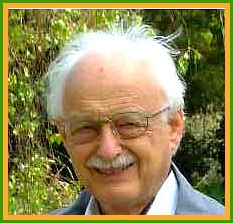“Infrasound: The hidden annoyance of Industrial Wind Turbines” (France)
Mar 2, 2011
Editor’s note: The remarkable thing about the following article is that it was written by Prof. Renard years ago. Although it does not bear a date, WTS.com first became aware of it (if memory serves) 5 or 6 years ago. It simply appeared on the French website, Vent de Colère. Yes, in French. (Our French is pretty decent, and we did look it over, but we failed to grasp its full import.) Notice, however, that Prof. Renard says in his first paragraph that this is a revision of a lecture he delivered in 1997! Wow!
In other words, he was talking about Wind Turbine Syndrome long before it had a name and years before there was a Nina Pierpont or Amanda Harry or any other physician pondering the subject.
On further reflection, perhaps it’s not so remarkable after all, given that Prof. Renard was faculty at the French Naval Academy, where he specialized in underwater acoustics and “noise quieting” technology. Infrasound has been, for many years, a subject of absorbing interest to the military, especially the navy. One of the puzzles being the problem of silencing engine and propeller low frequency noise (LFN) aboard naval ships (not just submarines) and merchant marine vessels.
In any case, what’s fascinating is that it took a Navy infrasound specialist to join the dots between what he knew as a noise engineer, and the reports filtering in away back then from people living near industrial wind turbines—to join the dots and point to infrasound—yes, wind turbine infrasound—as the obvious source of their distress.
Apparently he was saying this years before Dr. Amanda Harry and certainly well before Dr. Nina Pierpont made the same observations.
A final observation. Dr. Harry was assisted in her WTS research by working closely with a British noise engineer and physicist named Dr. David Manley.
I am Dr. David Manley, Chartered Physicist, Acoustician and Engineer.
Much work has been done by me near windfarms to evaluate the acoustic effects. It is found that people living within five miles of a windfarm cluster can be affected and if they are sensitive to low frequencies, they may be disturbed.
I am currently working in conjunction with Dr Amanda Harry, a practicing physician in this subject, and she has over fifty examples of people affected by low frequency windfarm noise.
What is happening is the high velocities of the large turbines’ wind foils cause aerodynamic noise modulated by the regular dynamic pulse when the wind foil [blade] passes the base [tower] of the turbine.
It has been found that an extensive seismic signal passes through the earth and may well, at night-time, affect people’s sleep. It is admitted by fellow acousticians that much more research in this subject is needed and that none has been done since 1996 by the DTI [former Dept. of Trade & Industry, United Kingdom]. At many inquiries, windfarm promoters will not accept there is an acoustic problem.
We are getting much data from Europe, as well, to paint a more accurate picture, and feel that no more windfarms giving an alternative to power stations should be built. I gave two talks as an invited speaker at the recent successful Saddleworth Conference. These talks were about the evidence of “hot lines” from clusters of turbines, which will at times cause much higher LFN signals than first thought.
Surely this is where Dr. Harry got her training in LFN—from Manley.
The problem is, Manley died (2006). Shortly after he died, Dr. Harry abandoned the nascent field of WTS, informing Dr. Pierpont (personal communication) that she was no longer available to discuss the subject—a subject she, herself, helped define.
·
—Professor Claude Renard (retired)*†‡
Naval College & Military School of the Fleet (France)
·
Click here for a PDF of the following article.
Click here for the original article, in French.
·
Introduction
This article is an updated summary of a lecture given by the author in 1997, entitled “Infrasound: Quiet, Pernicious Pollution.” At that time, it was given in response to concerns arising from the marketing in Sweden of a non-lethal infrasound weapon designed for riot control, the recognition of “Sick Building Syndrome” (SBS) caused by infrasound emitted by air conditioning systems, and the increase in the number of wind turbine installations in Brittany.
The rural areas of this region have a high population density, and the nuisances caused by infrasound would be as great or even greater than that of the visual pollution or radio interference preventing television reception.
In the weeks that followed, several points of information came to light, revealing that, in the first Airbus 340 planes, the setting of the pressurisation was such that it caused infrasound that affected the passengers. It was also disclosed that a “Euralille” high-rise block in Lille (France) had been evacuated due to vibrations on the 5th floor. Reports revealed that 644 agents of the new “Archet” hospital in Nice (France) had suffered from nausea and headaches. Some had even had to be admitted to the hospital. In 2005, there were accounts of similar health problems at the “Nord” hospital in Marseille.
This article has now been published in response to some good news: The (French) Académie de Médecine has recommended to the (French) government that the construction of wind turbines exceeding 2.5 MW at less than 1500 m from dwellings should from now be suspended.
This is good news, but not very good news. The writer is concerned that this venerable institution has only taken into account the ”annoyance” caused by audible noise (hissing of the blades, the noise from the gearings in the multiplier), and not the annoyance caused by infrasound. In view of this omission, the aim of this article is to inform the public about these inaudible but harmful noises.
In this article, the word “decibel” (dB) is not used, as it can lead to confusion. In fact, acoustic engineers use a different decibel than underwater acoustic engineers, because it relates to a different power reference level. In addition, they use decibels with an “A” weighting (dBA) as well as weighting for average sound levels over a given period of time: Leq dBA. (Infrasound is not included [in A-weighting].)
Longitudinal Waves
Humans are sensitive to longitudinal waves. These waves have their point of origin in a homogenous medium (air or water) as soon as there is a variation in pressure at any point in this medium. The wave is therefore characterised by its frequency N in Hertz (Hz), which corresponds to the number of times per second the pressure oscillates at any given point. The amplitude of this wave corresponds to the value of the increase or decrease in pressure expressed in Pascals (Pa).
The wave has the effect of compressing and then expanding the medium gradually in the direction of propagation. The molecules of the medium vibrate on the spot and gradually, through elasticity, induce vibration of the adjacent molecules in the direction of propagation of the wave. This is why these waves are also described as elastic waves.
The speed of the propagation of energy C in metres per second (m/s) (proportional to the square of the amplitude) is about 340 m/s in ambient air, and does not vary as a function of the static atmospheric pressure. In water, the speed is about 1500 m/s.
The amplitude of a longitudinal wave decreases as it gets farther away from its source, inversely to the distance D (in metres) travelled. This is divergence attenuation (the wave is spherical). A decay exponential for fading must be added to this attenuation, with the distance D multiplied by a coefficient specific to the medium and proportional to the square of the frequency N.
Another property of these waves is that they can be reflected at the point of change of medium, for example when moving from air to water. They can also be refracted if the medium changes the speed C of the waves during their propagation, for example where there is a localised change in air temperature. The ray paths can be curved where there are temperature gradients.
In addition, if there is a current in the medium of propagation, such as wind in the atmosphere, for example, ray paths propagating in an upwind direction will be lifted from the ground and curved up towards the zenith, and those propagated downwind will be driven towards the ground and curved down towards the nadir.
When longitudinal waves reach a human body and are able to cause the eardrums to vibrate significantly, they can be heard if the frequency N is between 20 and 20,000 Hz.
Audible Sound Waves
It follows that audible sound waves are longitudinal waves that have frequencies between 20 Hz and 20 kHz. The human ear starts to perceive them over and above a threshold of hearing. This threshold depends on the frequency of the wave.
The ear is surprisingly sensitive between 1 kHz and 3 kHz, as it can hear sounds of 2 / 100,000ths Pascal, whereas normal atmospheric pressure is 101,500 Pa. On the other hand, at 50 Hz the threshold is only 2 / 1,000ths Pascal. The ear is therefore 100 times less sensitive at this frequency.
During a conversation, the sound level is about 1 / 100ths to 2 / 100ths Pascal between 100 Hz and 4 kHz.
In addition, if the amplitude of the sound intensifies, over and above a certain level known as the threshold of pain, people suffer very sharp pain in the head and nausea. If a person stays in this environment, lesions to the cochlea in the ear will appear. This threshold is around 60 Pa.
It is possible to stay in a noisy environment without ear protection for a certain period of time a day without getting lesions, provided the intensity of the sound is lower than the threshold of pain. For example, at 2 Pa, it would be for 2 hours a day, and at 1 Pa for 4 hours a day.
In less noisy environments, people can suffer from noise annoyance which prevents them from sleeping, from thinking, or concentrating on a task, etc. In practice, it is not believed there is annoyance under 5 / 1,000ths Pascal. (This is the field of psychoacoustic studies.)
Just as humans are almost blind, in that they don’t see ultraviolet or infrared light, they are also nearly deaf, as they do not hear ultrasounds (N > 20 kHz)—unlike dogs and bats, for example—or infrasound (N < 20 Hz), which is used by certain animals such as elephants and giraffes [and whales] for communicating.
As we have seen, the attenuation of sounds is proportional to the square of their frequency N. Ultrasounds will not be dealt with in the rest of this article, since they are very quickly absorbed or reflected. However, this is not the case in respect to infrasound, which is also perceived by humans, though in a different way.
The Propagation of Infrasound
An audible wave of 1 kHz will be attenuated 10,000 times more than an infrasonic wave of 10 Hz under the same conditions of emission and reception, and following the same propagation path.
The wave length L in metres (m), being the distance separating two successive peaks during the propagation of a wave, is equal to the ratio of the speed C in m/s to the frequency N in Hz, ( L = C / N).
For infrasound having a frequency N of less than 20 Hz, this wavelength is much longer than that of audible sounds, and diffraction by obstacles such as trees and bushes is greatly reduced. The same applies to additional attenuation due to atmospheric turbulence.
For this reason, infrasound propagates over considerable distances and will therefore be affected by slow variations in the physical parameters of the medium. For example, in an adiabatic atmosphere where the temperature drops by 9.8° Celsius for every 1,000 m of altitude, an infrasonic ray emitted horizontally will curve up towards the zenith and will be capable of going over an obstacle of one metre at a distance of 316 m from its source, or an obstacle 10 m high at a distance of 1,000 m. It could also go over a hill 100 m high situated at a distance of 3.16 km.
Generally speaking, infrasonic rays move upwards until they reach an altitude where they encounter either a temperature gradient which inverts (inversion zone) or a wind gradient. In both instances, as we have already seen, the ray path will curve downwards towards the ground (or the sea), where it can be reflected very easily despite the vegetation (or the waves), and gradually rebound.
In this way, infrasound is guided far away from its source, which explains why, for example, the explosion of Mount St. Helens (USA) on 19th May 1980 was felt all over the world. It is also the way in which elephants are able to communicate with each other over tens of kilometres thanks to the temperature inversion zone that forms from sunset to sunrise.
Knowing that infrasound can be perceived at great intensity even when it is far from the source that produced it, we are now going to look at the perturbations they can cause to humans who cannot hear them.
The Physiological Effects of Infrasound
It was a Frenchman, V. Gavreau, who, during the Sixties, first reported human health problems caused by exposure to infrasound. The symptoms resembled seasickness, accompanied by headache, nausea, and dizziness which led to “deep nervous fatigue.” He was also the first to mention eye problems and the impossibility of concentrating on a task.
In the Seventies, a Dane, P.V. Brüel, manufacturer of acoustic metrology equipment, showed that symptoms were felt after only 5 minutes of exposure to infrasound of an amplitude of 1 Pa and a frequency of 12 Hz. He also demonstrated by measurements taken in an estate car travelling at a speed of 100 km/h that the level of infrasound which was almost constantly at 1 Pa between 4 and 16 Hz contributed to “car sickness.”
In addition, P.V. Brüel carried out some very interesting measurements of the level of infrasound on the top floor of a sixteen-floor high-rise block when there was a fairly strong wind blowing. The infrasound reached 6 Pa at 1 Hz and dropped to 0.2 Pa at 16 Hz. The signal spectrum showed resonances at 4 Hz (2 Pa), 8 Hz (1Pa) and 12 Hz (0.4 Pa).
In the USA in 1975, D.L. Johnson defined the threshold levels above which people feel unwell : 0.2 Pa at 20 Hz, 0.6 Pa at 10 Hz, 2 Pa at 5 Hz, 20 Pa at 2 Hz, and 60 Pa at 1 Hz.
In Japan in 1991, H.Takigawa reported that infrasound of 1 Pa between 3 and 7 Hz had an influence on the vestibule of the ear and lead to ocular reflexes (nystagmus), spinal reflexes (tremors), and autonomic reflexes (dyspnoea).
In 1991, the Russian, B. Fraiman, noted the effect of infrasound of 2 Pa on blood pressure, which confirmed the problems of diastolic pressure mentioned in 1974 by Borredon (1 Pa = the pressure of a column of water 10 cm high).
To summarise, infrasound is capable of causing:
- Headaches
- Dizziness
- Nausea
- Nystagmus
- Tremors
- Dyspnoea
- Circulation problems
Sources of Infrasound
Other than infrasound emitted by animals, the sources of infrasound are either natural or manmade. Periodic natural sources are caused by the volcanic eruption, supersonic booms, storms and fractures such as during earthquakes, avalanches and calving of icebergs from glaciers.
Other transient sources are caused by tornadoes (whirlwinds), the flow of wind over natural (mountains) or man-made obstacles (wind turbines, bridges, towers, churches, houses). Oceans and waterfalls are continual natural sources. There are other man-made sources, such as internal combustion engines and ventilation or air conditioning installations.
The remainder of this article deals with sources which are mainly due to noises of turbulent flow of air on obstacles. This causes the formation of Von Karman swirling paths (called Von Karman vortices), which are made up of a series of eddies swirling alternately in one direction and then the other. They emit both audible and inaudible sound, which is either jet sounds for which the frequency N (in Hz) is given by the Krüger and Marsherer formula: N = (0.055), V/E, where V is the wind speed (in m/s) and E the distance (in m) between the two obstacles limiting the jet, or trail sounds on an obstacle having a thickness or diameter E, for which the emission frequency is given by the Strouhal and Krüger formula: N = (0.2), V/E. In the latter case, the eddies are alternately emitted by one edge and then the other of this long obstacle. Depending on the speed of the wind, these phenomena can become audible and cause the whistling emitted by windows that are badly closed, or by electric wires or cables.
The infrasound produced by wind turbines (the tower and the rotor blades) falls under this category. M.L. Legerton’s team (Inter-Noise 96) showed that, at 100 m from a wind turbine, the infrasound had peaks of 1.4 Pa emitted every 0.65 sec. as the rotor blades passed the wind turbine tower.
Today, the audible sound produced by the blade tips is considerably less, due to improved blade design. The infrasound produced by centrifugal or axial fans is caused by the “flow separation” (pumping) phenomenon. This causes pressure variations which are amplified by the pipe work.
Conclusion
The information given above is enough to understand that it is better not to be exposed to infrasound which propagates far from its point of origin and against which it is impossible to protect oneself due to the long wavelengths.
Those most affected by exposure to infrasound are rural inhabitants living in proximity to wind turbines, and those working in air-conditioned offices.
The people in the former category are exposed to the infrasound 24 hours a day, whereas people in the latter category are only exposed to infrasound 6 hours a day.
The most important issue is therefore to know what intensity of infrasound can be tolerated without inconvenience over these periods of time.
We do not have the answer to this question. During the Seventies, many studies were carried out by army physiologists to find out how long it was possible to stay in a tank where the level of infrasound is in the region of 20 Pa, in the engine room of a ship where there can be levels exceeding 100 Pa at 5 to 20 Hz, and in a space capsule where the level is between 400 and 600 Pa at 1 to 20 Hz. Their problem was in fact to know how long military personnel could carry out their duties under these conditions. The results were kept secret.
In 1976, Von Gierke put forward a limit of 20 Pa between 1 and 20 Hz below which a human being could be exposed for 24 hours without harmful effects. In fact, those who live near waterfalls or by the sea, where levels of infrasound can vary from 1 to several Pascals, can confirm this.
It would seem that infrasonic noise that does not contain particular frequencies (white noise) is easier to tolerate. It is therefore better to concentrate attention on the power spectral density expressed in Pascals squared per Hertz. In 1993, B.J. Fraimann measured on the Pacific coast a power density G varying 1/N with the frequency signature of the atmospheric turbulence.
It is clear that there is wide scope for further research, which we would like the appropriate government ministries to initiate. In addition, research on the effects of infrasound on animals needs to be carried out.
In the meantime, the application of the Precautionary Principle would be appropriate, in particular with respect to the decision to install wind turbines.
·
*Specialist in submarine acoustics & “acoustic quieting.”
†The article has no publication date. It seems to have been published, however, 5 or 6 years ago.
‡Trans. Elizabeth Chafer, ed. Calvin Luther Martin, PhD
·
WTS.com dedicates this article to
Dr. Geoff Leventhall
·
Bibliography
F. Cordier «Le mystère de l’hôpital Nord de Marseille» Le Quotidien du Medecin du 1er Septembre 2005.
M. Rossi «Electro-acoustique» Dunod éditeur 1986 p 34 et p 115 à 148.
«Lemonde des sons» Dossier hors série de pour la Science, Juillet/Octobre 2001.
V. Gavreau, R. Condrat & H. Saul «Infra-sons: Générateurs, détecteurs, propriétés physiques, effets biologiques» Acoustica vol 17, no. 1, 1966, p 1 à 10.
V. Bruel & H.P. Olensen «Mesures infrasonores» Technical Review Brüel & Kjaer No. 3, 1973, p 14 à 26.
D.L. JOHNSON «Auditory and physiological effects of infrasound» Internoise 75 , 1975, p 475 à 482.
H. Takigawa, H. Sakamoto & M. Murata «Effects of infrasound on vestibular function» Journal of Sound and Vibration, vol 151 (3), 1991, p 455 à 460.
B.J. Fraiman, A.N. Ivannikov, V.I. Pavlov «The experimental investigations of low frequency noises in the everyday life» Internoise 93 , 1993, p 1157 à 1160.
P. Borredon, J. Nathie «Effets physiologiques observés chez l’homme exposé à des niveaux infrasonores de 130 dB» In L. Pimonov, ed., Colloque international sur les Infrasons, C.N.R.S. Paris 1974, p 59 à 84.
A. Foch «Acoustique» Collection Armand Colin, 1947, p 184 à 187.
M.L. Legerton et al. «Low frequency noise & vibration levels at modern wind farms» Internoise 96, 1996, p 460 à 462.
William T.D. Cory «Le décollement tournant et le choix des ventilateurs pour les unités de traitement d’air» Acoustique & Techniques No. 8, Janvier 1997, p 11 à 15.
H.E. von Gierke, C.W. Nixon «Effects of intense infrasound on man» in Infrasound and Low Frequency Vibration, ed. W. Tempest, Londres et New-York: Academic Press, 1976.










Comment by gail on 03/02/2011 at 10:57 am
Hi Nina and Calvin,
We’re still in there and fighting. The photo of the abandoned house made me think of ours—abandoned January 2007 (Tuscany, Italy).
I read the letter to Leventhall and I think you’re right about the gesture for “quotation” marks: Brits don’t cross their fingers as far as I know, but I’ve been on the “Continent” for so long now, it may be a European thing—first and middle fingers, uncrossed.
Every article you post is extremely useful!
Comment by Simon on 01/05/2014 at 5:46 am
Very useful article! If you go to the website of Mr. Sengpiel (a German audio engineer decorated with several Grammy awards) http://www.sengpielaudio.com/calculator-soundlevel.htm you will find an online calculator that converts Pascals (Pa) to the more familiar dB scale – this approach is not 100% correct (as Calvin already pointed out) but gives you a rough idea of the magnitude of the IS Mr. Renard is talking about.